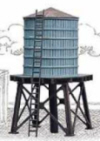How, What and Why of Water Tanks on Your Property in Panama

-Why do we have big water tanks on our properties???-Ever wonder what the water tank is for, or why some are way up in the air?Unfortunately the water supplied by IDAAN (Instituto de Acueductos y Alcantarillados Nacionales or National Institute of Aqueducts and Sewers) is less than consistent. Major fluctuations in pressure, and even complete water outages are common occurrences. A water tank can supply water to get through those times.
The IDAAN water is supplied by large pumps and tanks. If there is a water main leak, apparently they have to cut off all the water to make repairs. During periods of heavy usage, their capacity may not be great enough to keep up with the demand. If they reduce pressure, they will lower the water consumption per hour. Notice how slow the water runs when the pressure goes down? I don't know the reasons for the problems, and I don't know enough Spanish yet to ask.
The water tank is a large storage container. With the aid of a pump, you can use it when the pressure gets too low, say below 15 pounds per square inch (PSI). A tank would have to be large enough to supply water for the period of time that you need the extra pressure, and hopefully refill from IDAAN when you finish. So how big does the tank have to be? The average person used 75 gallons of water per day for laundry, showers, consumption, etc. Therefore a family of two would use 150 gallons per day. This does NOT include topping off your pool or watering the lawn.
Pools and irrigation use large quantities of water. A pool 25 feet long by 15 feet wide would use 234 gallons just to bring the water level up 1 inch. I run two sprinklers in the morning. Even with reduced pressure of 18 PSI, they consume 5.5 gallons per minute (GPM). In two hours, that's 660 gallons of water consumed.
For those of you with your calculators ready, 264 gallons equals 1 cubic meter.
Now, if the IDAAN supply goes off completely, even with a tank you will certainly run out of water if you don't conserve. If the water pressure is low, and the water goes off for only a portion of the night, the tank should work for you.
Getting back to the size, a local handyman suggested a 600 gallon tank for a family of two. My issue with that is the physical size, weight, extra cost, and the idea that such a large amount of water might get contaminated with algae, since it might not get used up as much as the water in a conservatively-sized tank would. I'm really not a fan of using pool chemicals in my drinking water, but I know that many people do. I manage to take the chlorine OUT of my water with shower head filters and drinking water filters. However the chemical method may be the only way to keep the water algae-free and bacteria-free. If I choose 300 gallons for a
family of two, and the municipal water is on most of the day, I should be OK. I would be using roughly half the water from the tank, and half from IDAAN.
600 gallons of water weighs 5010 pounds or 2272 kilograms.
Do you want to put that tank way up in the air? Why do some people do that? The reason is to seemingly get water pressure without needing a pump. While is sounds like a great idea, there are practical factors to consider and you need to know some physics about water. Water is heavy. Because of that, if you put a tank high-in-the-sky, you will get pressure. For each foot of elevation, you will have 0.434 PSI. To get 20 PSI or more at a faucet, the bottom of the tank needs to be 46 feet above that faucet! If the shower head is 10 feet above ground level, the bottom of the water tank needs to be 56 feet off the ground!
That's a big, expensive and useless tower.
The other problem here is IDAAN. In order to refill the tank, the water pressure will have to be greater than 27 PSI. Since that doesn't happen too often, you will now need a pump to FILL the tank. Since you'll need a pump either way, leave the tank on the ground.
********
John July
Level 6 Certified Water Specialist and
Certified Installer with the U.S. Water Quality Association.
He is the founder of Water Solutions, incorporated in 1996, with over 2100 customers in 49 states and 13 countries.
